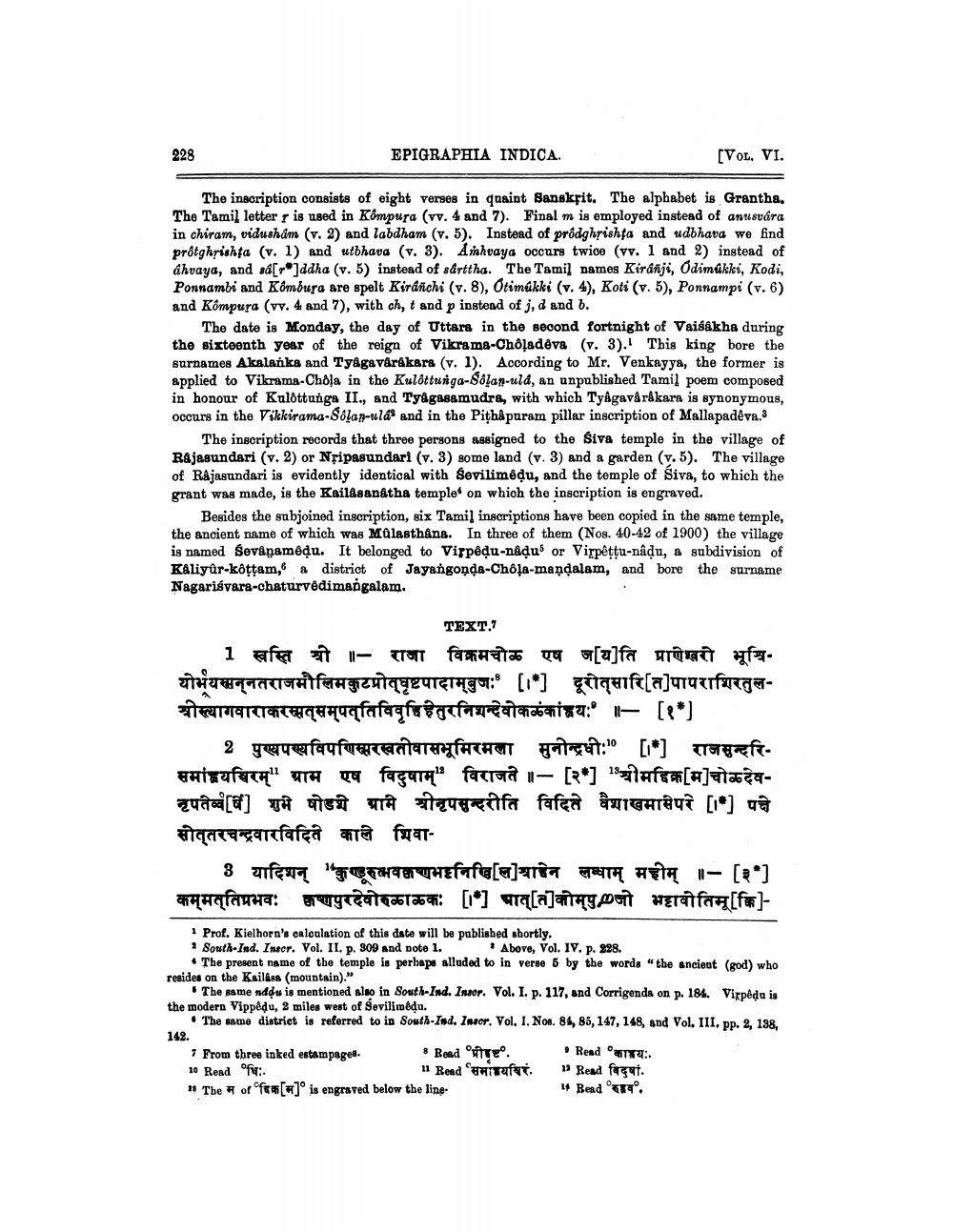________________
228
EPIGRAPHIA INDICA.
[VoL. VI.
The inscription consists of eight verses in quaint Sanskfit. The alphabet is Grantha, The Tamil letter r is used in Kompusa (vv. 4 and 7). Final m is employed instead of anusvára in chiram, vidushám (v. 2) and labdham (v. 5). Instead of prôdghrishta and udbhava we find prôtghrishta (v. 1) and utbhava (v. 3). Anhuaya occurs twioe (vv. 1 and 2) instead of dhvaya, and så[r"]ddha (v. 5) instead of sårttha. The Tamil Dames Kiráñji, Odimúkki, Kodi, Ponnambi and Kômbura are spelt Kiráñchi (v. 8), Otimákki (v.4), Koti (v. 5), Ponnampi (v. 6) and Kompura (vv. 4 and 7), with ch, t and p instead of j,d and b.
The date is Monday, the day of Uttara in the second fortnight of Vaisakha during the sixteenth year of the reign of Vikrama-Chôļadēva (v. 3). This king bore the surnames Akalanka and Tyagavarākara (v. 1). According to Mr. Venkayya, the former is applied to Vikrama-Chola in the Kulôttunga-Solanuld, an unpublished Tamil poem composed in honour of Kulottunga II., and Tyâgasamudra, with which Tyagaväråkara is synonymous, occurs in the Vikkirama-Solanulds and in the Pithåpuram pillar inscription of Mallapadeva.
The inscription records that three persons assigned to the Siva temple in the village of Rajasundari (v.2) or Nripasundari (v. 3) some land (v. 3) and agarden (v.5). The village of Rajasundari is evidently identical with Sevilimêdu, and the temple of Siva, to which the grant was made, is the Kailasanatha temple on which the inscription is engraved.
Besides the subjoined inscription, six Tamil inscriptions have been copied in the same temple, the ancient name of which was Malasthana. In three of them (Nos. 40-42 of 1900) the village is named Sevanamedu. It belonged to Virpedu-nadus or Virpettu-nadu, asubdivision of Kaliyur-kottam, a district of Jayangonda-Chola-mandalam, and bore the surname Nagarisvara-chaturvedimangalam.
TEXT. 1 स्वस्ति श्री ॥- राजा विक्रमचोळ एष ज[य]ति प्राणेश्वरो भूथियो यस्मन्नतराजमौलिमकुटप्रोत्घृष्टपादाम्बुजः [*] दूरोत्सारि[]पापराशिरतुलश्रीस्त्यागवाराकरस्मत्सम्पत्तिविवृदिहेतुरनिशन्देवोकळंकांवयः ॥- [१]
2 पुण्यपण्यविपणिस्मरखतीवासभूमिरमला मुनीन्द्रधी: [*] राजसुन्दरिसमायश्चिरम्" ग्राम एष विदुषाम् विराजते ॥- [२*] श्रीमविक्र[म]चोळदेवनृपतेव्व[ष] शुभ षोडशे पामे श्रीनृपसुन्दरीति विदिते वैशाखमासेपरे [*] पक्षे सोत्तरचन्द्रवारविदिते काले शिवा
3 यादिशन् “कुण्डरुभववष्णभनिखि[लाइन लब्धाम् महीम् ॥- [३] कम्मत्तिप्रभवः कृष्णपुरदेवोरकाळकः [*] पात्[त] कोम्पु.pजो भट्टावोतिमू[कि]
I Prof. Kielhorn's calculation of this date will be published shortly. 1South-Ind. Ineer. Vol. II. p. 309 and note 1.
Above, Vol. IV. P.228. • The present name of the temple is perhaps alluded to in verse 5 by the words "the ancient (god) who resides on the Kailass (mountain)."
. The same nddu is mentioned also in South-Ind. Insor. Vol. I. p. 117, and Corrigenda on p. 184. Vixpēdu is the modern Vippedu, 2 miles west of Sevilimdu.
• The same district is referred to in South-Ind. Insor. Vol. I. Nos. 84, 85, 147, 148, and Vol. III, pp. 2, 138, 142. 7 From three inked estampages.
Read प्रीपष्ट. Read 'कायः . 10 Read of:.
1 Read 'समायविरं. Read विदुषां. " The म of°विक[म] is engraved below the line
" Read कावी.




